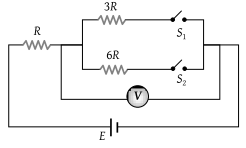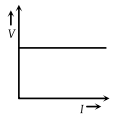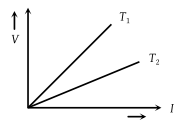In the circuit shown in figure reading of voltmeter is V1 when only S1 is closed, reading of voltmeter is V2 when only S2 is closed and reading of voltmeter is V3 when both S1 and S2 are closed. Then

(1) V3 > V2 > V1
(2) V2 > V1 > V3
(3) V3 > V1 > V2
(4) V1 > V2 > V3

Current through wire XY of circuit shown is :
(1) 1 A
(2) 4 A
(3) 2 A
(4) 3 A
\(12\) cells each having the same emf are connected in series with some cells wrongly connected. The arrangement is connected in series with an ammeter and two similar cells which are in series. Current is \(3~\text{A}\) when cells and battery aid each other and is \(2~\text{A}\) when cells and battery oppose each other. The number of cells wrongly connected is/are:
1. \(4\)
2. \(1\)
3. \(3\)
4. \(2\)
Following figure shows cross-sections through three long conductors of the same length and material, with square cross-section of edge lengths as shown. Conductor B will fit snugly within conductor A, and conductor C will fit snugly within conductor B. Relationship between their end to end resistance is
(1) RA = RB = RC
(2) RA > RB > RC
(3) RA < RB < R
(4) Information is not sufficient
In the following star circuit diagram (figure), the equivalent resistance between the points A and H will be
(1) 1.944 r
(2) 0.973 r
(3) 0.486 r
(4) 0.243 r
In the circuit of adjoining figure the current through 12 Ω resister will be
(1) 1 A
(2)
(3)
(4) 0 A
The resistance of the series combination of two resistance is S. When they are joined in parallel the total resistance is P. If S = nP, then the minimum possible value of n is :
(1) 4
(2) 3
(3) 2
(4) 1
Which of the adjoining graphs represents ohmic resistance ?
(1)
(2)
(3)
(4)
Variation of current passing through a conductor with the voltage applied across its ends varies is shown in the diagram below. If the resistance \((R)\) is determined at points \(A\), \(B\), \(C\) and \(D\), we will find that:

| 1. | \(R_C = R_D\) | 2. | \(R_B>R_A\) |
| 3. | \(R_C>R_B\) | 4. | None of these |
The voltage V and current I graph for a conductor at two different temperatures T1 and T2 are shown in the figure. The relation between T1 and T2 is :
(1) T1 > T2
(2)
(3) T1 = T2
(4) T1 < T2











